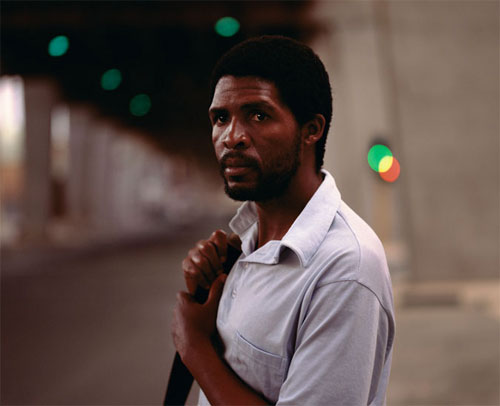The large cibachrome photographs in Juul Hondius’ show "Faction" were all suggestive of phenomena like illegal immigration, asylum seekers, refugees and civil war. In an age in which winning entries for the World Press Photo competition usually are highly aesthetic
and carefully composed, no matter how gruesome the subject-matter, Hondius' glossy depictions of politically charged scenes cause a flash of recognition.
Un/Defender (2000) shows a man in a white cape leaning in apparent exhaustion and despair against a ‘Defender’ Landrover in a muddy field. Although the scene has been staged in Holland, the word Bosnia seems to be written all over it. The fact that the man seems overly groomed, like a model in a fashion shoot, only underlines the image’s power. It may be overly perfect, but not so much that the connection with the media imagery on which Hondius draws is lost. If the man’s gesture is rhetorical, this is precisely the rhetoric of grief and despair, whose roots lie in classical western painting, that news photographers exploit. Some works suggest narrative connections: the man who is seen leaving a coach in Man # 1 (1999) is making his way through a wood on the other side of a water in Crossing (2000). The title reinforces the suggestion that he is illegally crossing a border, similar to the way in the UN/Defender title reinforces the Bosnian connection. The bland Auto, on the other hand, says nothing about the suggestive 1999 image of damp car windows though which some people are dimly seen, suggesting perhaps a drug deal or some other shady activity. The work appears to demand a more explicit, more narrative and newspaper-style caption. While this emphasizes that photographs are only able to function in the news media because an explicit content is given to them by captions and articles, it also points out that many images have as it were inherent captions. By using highly coded elements from previous photography and film, they forge a seemingly natural link between visual rhetoric and written rhetoric. The somewhat more ambiguous Bus (2000) shows black people dozing in a bus. The low perspective from across the isle was created by shooting the photo in a bus that was sawn in two, yet this ‘impossible’ perspective only serves to make the image more convincing and hence emphasizes its reality effect. The sleepiness of the scene is reminiscent of David Goldblatts’ pictures of black South-Africans being driven from ‘homelands’ to their work and back again each day on absurdly long journeys. But the daylight contradicts this association, and the imagination drifts off to the USA, where fully-functioning citizenship seems to be linked to owning a private car, and the bus is the domain of the poor and ethic minorities. (The script of the film Speed emphasized that Sandra Bullock had to take the bus because her driving-license had been revoked – otherwise the film’s premise would have been too improbable even for a Hollywood blockbuster.) Hondius’ works would not be so successful if he were merely trying to demonstrate, once more, that images can be deceptive and that the mass media are particularly deceitful. His main interest appears not to be the veracity of an image, but the development of a critical
iconography of the present. Virtually all the images have to do with mobility and borders, and ensuing problems such as smuggling and other crimes, civil war and immigrants ‘penetrating’ the borders of the nation state. Although Hondius does address the question of the photographic construction of ‘naturalness’ trough a canny actualisation of visual clichés, his overriding interest seems to be the way in which these clichéd yet new images form part of a pathological iconography – an iconography of travel, stemming from and fuelling a widespread fear and fascination of globalised flows of commodities, capital and humans.











No comments:
Post a Comment